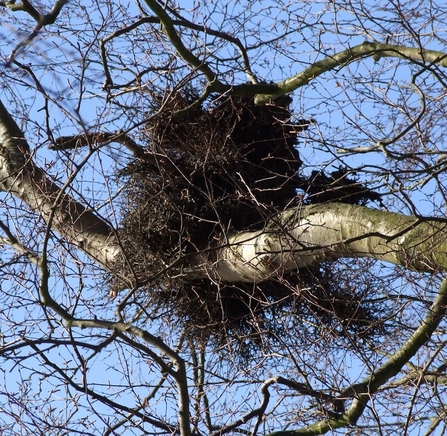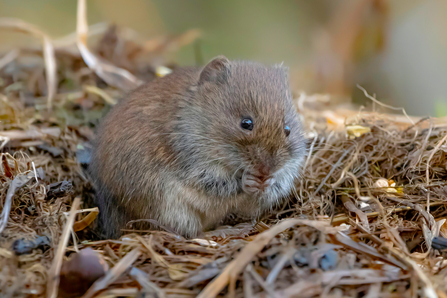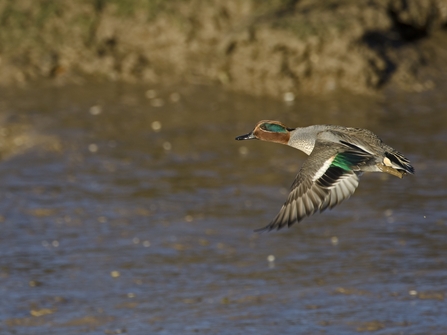
Bittern by Jamie Hall
Lapwing in flight by David Tipling/2020VISION

Bittern by Jamie Hall
We are fortunate enough to have a bird, once extinct in Britain, now regularly seen in our area, particularly in winter as migrants move inland. The bittern is a thickset species of heron with incredible camouflage that helps it blend in with its favoured habitat of reedbeds.
Time spent in a reedy area such as Calvert Jubilee, Hosehill Lake, and Thatcham Reedbeds could reward the patient birder. An added bonus whilst waiting for a bittern is hearing pig-like squeals from the reeds! This is the unmistakeable call of a water rail hiding in the vegetation.

Witches' broom by Philip Goddard CC BY-NC 2.0
As the trees lose their leaves, the structure beneath is revealed and you may see lots of what looks like bird nests. Look more closely and you’ll see that many of them are in fact profusions of tiny twigs growing from the tree itself, often called witches’ brooms.
They are caused by fungi – different types in different trees – which stimulate the tree to create these abnormal growths so that they can feed off the shoots. They’re classified as a type of gall, as the process is similar to the one that creates the growths often seen on oak leaves.

Shaggy inkcaps
Fungi can be found all over at this time of year, and it’s fascinating to see them emerge as if from nowhere after damp weather - but keep watching as they mature and eventually decompose too. You might be lucky enough to spot a puffball exploding, or watch a blackening waxcap turn from bright orange to black.
Inkcaps are particularly dramatic as they mature. These pictures are both shaggy inkcaps! In a process called deliquescence or auto-digestion, the mushroom liquefies itself through the release of various enzymes that interact with moisture (if it’s too dry, the mushroom will simply shrivel). It’s thought this helps them release spores.
See the best reserves for fungi
Please make sure you leave all fungi where you find them for others to enjoy. Fungi picking or foraging is not permitted on our nature reserves.

Bank vole by Mark Lauri
A chill in the air tells us that winter is not far behind, and among the mammals that are preparing to hide from the cold weather are bank voles. These small, furry rodents live in underground burrows and feed on plants, using the remainder of autumn to stockpile fruits, nuts and seeds to see them through to the spring. Look out for them in meadows like our Iffley Meadows nature reserve in Oxford.
This fantastic shot of a hungry hoarder by Mark Lauri was the winner of the 'mammals' category for this year's photography competition.
Red fox by Logan Walker
While many animals are bedding down for the winter, November is the peak month for male fox dispersal: cubs born in spring are now fully grown and leaving to find their own territory. Dogs go first, followed by vixens. The fox breeding season starts next month, but you might start to hear the first calls now: listen out for barks and howls late into the night.

A male teal displaying a flash of green in flight. Photo by David Tipling/2020VISION
The teal is our smallest duck. Males are grey, with a speckled breast, a yellow-and-black tail, a chestnut-coloured head and a bright-green eye patch. Females are mainly mottled brown, but both sexes show a bright-green wing patch in flight. Listen out for the mournful but shrill whistle, an iconic winter sound.
They can often be seen in large numbers along with wigeon and pintail at flooded gravel pits like our College Lake reserve near Aylesbury.

Arils (yew berries) on a tree in an Oxfordshire churchyard. Picture: Pete Hughes
Other colourful icons to look out for in November are the bright-red yew arils. These fleshy berries are the only part of the yew tree that isn't toxic, and provide a valuable food source for hundreds of birds, as well as mammals as winter descends. Look out for enormous, ancient yew trees in country churchyards.

Pink waxcap © Guy Edwardes/2020VISION
Whilst you’re admiring the yews, keep a lookout lower down for pink waxcaps, one of our most beautiful waxcaps which can be found in churchyards and sheep-grazed pastures – their presence is an indicator of quality older grassland.
Waxcaps take their name from the texture of their toadstools, and there is an impressive population of these waxy wonders at Bowdown Woods near Newbury, including parrot, snowy, butter, honey, heath and meadow. Dry Sandford Pit near Abingdon is also home to the blackening waxcap and the scarlet waxcap.

Lapwing in flight by David Tipling/2020VISION
Named for its jaunty flight (from the Middle-English lappewinke, meaning to leap and waver) the lapwing is a highly attractive bird. Along with its iridescent green wings, white belly and smart black bib, it has a punky crest of feathers sticking out of its head. In winter, large flocks join other birds on farmland and wet fields, sometimes in their thousands.
Look out for them at our Chimney Meadows reserve near Witney or our Upper Ray Meadows network of reserves on the Oxon/Bucks border.

Waxwing ©Jon Hawkins - www.surreyhillsphotography.co.uk
Despite its name, the waxwing is not a bird-mushroom hybrid, but one of the UK's most colourful winter visitors and a favourite of birdwatchers! With its striking orange-and-black head, white-striped wings and yellow tail tip, it looks almost tropical picking the berries off trees.
Whilst there are usually some present each winter, sometimes thousands of these birds flock to the UK during the season. After several sparse years, 2023 enjoyed a ‘waxwing winter’ which saw an influx beginning in Scotland and northern England before spreading down to our three counties. Look out for large groups descending on anything with berries - such as rowan trees - in car parks and gardens. Who knows what this season will bring…
Discover more about waxwing winters